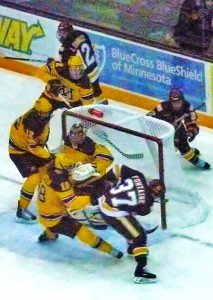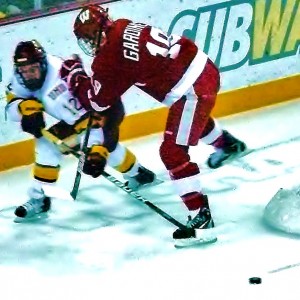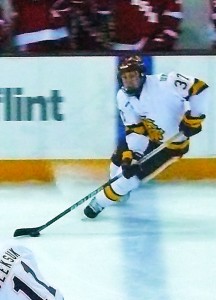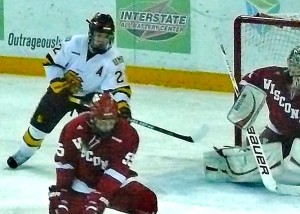UMD rink-rats rise to NCAA final
By John Gilbert
Most college hockey players who leave early to sign professional contracts don’t go directly to the NHL, and leave frustrated coaches behind while serving minor league apprenticeships somewhere such as the American Hockey League (AHL). At Minnesota-Duluth, where the Bulldogs will try for their first-ever NCAA championship Saturday night, the AHL is greatly responsible for the team’s success — but it’s a different AHL.
“It’s the Afternoon Hockey League,” said Bulldog coach Scott Sandelin, whose team takes on Michigan at 6 p.m. Saturday in the Frozen Four final at Saint Paul’s Xcel Energy Center.
UMD (25-10-6) is in its fourth NCAA Frozen Four, and has only reached the championship game one other time, in 1984, where the Bulldogs suffered an excruciating 5-4 loss in four overtimes to Bowling Green. Michigan (29-10-4) is chasing its 10th NCAA crown. But the last Wolverine titles came in 1998, and 1996, so none of the current Wolverines has any memory of them. But this group is working on its own platform.
Michigan won the CCHA season title by a point on the final day of the season, then was upset 5-2 by Western Michigan in the CCHA playoffs. Since the NCAA started, the Wolverines have embarked on what looks like a mission to knock off all the WCHA teams it can find in NCAA tournament play. The Wolverines beat Nebraska-Omaha 3-2 in overtime and Colorado College 2-1 to win the West Regional, then stunned North Dakota 2-0 with an empty-net clincher in Thursday’s Frozen Four semifinals. UMD, which beat Notre Dame 4-3 in the first semifinal, is the fourth straight WCHA team to try to prevent the Wolverines from raising their record supply of NCAA trophies.
To win its first NCAA title, UMD will have to rely on its “Gold” line, the unit with Jack Connolly centering Mike Connolly and Justin Fontaine. It is that unit that supplies the weaponry for UMD’s slick power play, which has carried the Bulldogs to an NCAA tournament run that shows East Regional victories of 2-0 over Union and 5-3 over Yale, before squeaking past Notre Dame 4-3. The Bulldog power play got both goals against Union, three of the five against Yale, and three of the four against Notre Dame. That means 8 of the 11 goals UMD has scored in the NCAA tournament so far have come with the man-advantage, and their 8-of-23 efficiency is 34.8 percent since the NCAAs began.
The outburst also has boosted the “Gold” linemates closer to the top of WCHA all-game scoring. North Dakota’s Matt Frattin leads with 36-24–60, but he was shut out against Michigan. Jack Connolly, who got a goal against Notre Dame, is now 18-41–59, Fontaine, who had 3 assists against the Irish, is 22-36–58, and Mike Connolly, who had a goal against the Irish, is 28-26–54.
“One thing we didn’t plan on against North Dakota was to take so many penalties, against that power play,” said Michigan coach Red Berenson. “And now we play Duluth, which has an even better power play.”
There are several reasons for the line’s great success. One is that they are familiar with each other and seem to think on the same wave-length, and all three are quick to share the puck as much as shoot it. The fact that they seem smoother and quicker than ever since the tournament started has nothing to do with extra practice, Sandelin said. But it might have a lot to do with UMD’s own version of the AHL.
“Nothing much that they do can surprise me now, because I’ve seen them so much,” said Sandelin. “I worry that when you see them every day, you might not appreciate them as much, but our power play is effective because we have different options, and the players we have on the power play like to create from within the group.
When it was suggested that the way they interact is less by design than it is improvisation, much like pond-hockey, or just being rink-rats, Sandelin quickly agreed.
“That’s basically what it is — rink-rat hockey, and the AHL. After practice every day, we have the AHL. We get our assistant coaches out there to play against our top players. Derek Plante, Brett Larson and Bill Watson are just like kids, just like the players. I used to go out there with them, and with , too. When we first added Derek, Billy’s first line was ‘Good, now our AHL team will have someone else who can get me the puck.’ ”
Watson was a Hobey Baker winner as a star winger on the UMD league championship teams of 1984 and ’85. Plante played later, and was a stickhandling and puck-moving wizard at center who went on to play in the NHL. Larson was a smart, quick defenseman, as was Sandelin. So when they go out as a penalty-killing unit, with Larson and Sandelin on defense, and Plante and Watson up front, it is formidible opposition. The free-spirited rink-rat game has carried over to the Frozen Four, and followed the team’s final practice of the season Friday at Xcel Center.
“Today we had Watson, Larson and Plante against the Gold line,” said Sandelin. “The Gold line won. They had lost to them the last time, so they owed them one.”
Another key to their success is that they’re in UMD’s own AHL, instead of possibly the American Hockey League. Because the unrelated Connollys are both 5-foot-8 juniors, and Fontaine a 5-foot-10 senior, none of the three has been pursued by the pros, the way they might be if they were less skilled but 6-foot-2. In fact, all three remain undrafted, and will be free to pursue free-agent deals with any NHL team. “It’s true,” said Sandelin. “If Mike Connolly, or Jack Connolly, were 6-feet, they wouldn’t be juniors at UMD.”
Their presence is required for such a strong power play, but it also requires two more ingredients for the five-man unit. One of the others is freshman defenseman Justin Faulk, who has been brilliant as a puck-mover or shooter from center-point on the blue line. In recent weeks, Sandelin moved freshman winger J.T. Brown onto that power-play unit, shifting Fontaine back to play the other point. Fontaine, who is called “Fonzie” throughout the team, moves up to the left circle while Faulk mans center-point, and as the Connollys maneuver around, either cycling the puck to each other in the right corner to get free in the right circle, or one of them moving to the slot, Brown works the end boards and and is dangerous passing or shooting for back-door plays.
Against Notre Dame, Brown scored from the left circle after a pass in by Faulk for the first UMD goal, and when it was 2-2, Faulk fed in from center point to Fontaine at the left circle, and he quickly relayed one of his trademark Fonzie passes, which is precisely placed in shooting position — this time to Mike Connolly in the slot for a goal. In the second period, the unit passed with dizzying precision until Fontaine circled out near the blue line, then passed deep on the left to Brown, who passed quickly through a defenseman’s legs and past goaltender Mike Johnson to the right circle, where Jack Connolly one-timed his shot so quickly that the ESPN cameras couldn’t catch him. The puck was in the net before Jack came into focus.
As for the match up with Michigan’s big, aggressive and creative team, it is comparatively unique. In all the years of having Division I hockey, UMD has played the Wolverines only one time. That was in 2001, at the Maverick Stampede. “I remember it,” said Sandelin, who was in his novice coaching time back then. “We went down to Omaha for the Stampede and beat Nebraska-Omaha the first night, then we beat Michigan 3-2. When I called home, my wife was more excited than I was. ‘You beat MICHIGAN?’ she said.”
After upsetting North Dakota Thursday night, Berenson stressed that North Dakota was the best team. “No way we match up,” he said. “But the best team doesn’t always win.”
Friday, Sandelin smiled and said, “Red’s been around a long time. He knows what to say. They did what they had to do to win against North Dakota. And so did we against Notre Dame. I think they can play better, and hopefully, we can too. It should be a great game.”
Comments
Tell me what you're thinking...
and oh, if you want a pic to show with your comment, go get a gravatar!






 John Gilbert is a lifetime Minnesotan and career journalist, specializing in cars and sports during and since spending 30 years at the Minneapolis Tribune, now the Star Tribune. More recently, he has continued translating the high-tech world of autos and sharing his passionate insights as a freelance writer/photographer/broadcaster. A member of the prestigious North American Car and Truck of the Year jury since 1993. John can be heard Monday-Friday from 9-11am on 610 KDAL(www.kdal610.com) on the "John Gilbert Show," and writes a column in the Duluth Reader.
John Gilbert is a lifetime Minnesotan and career journalist, specializing in cars and sports during and since spending 30 years at the Minneapolis Tribune, now the Star Tribune. More recently, he has continued translating the high-tech world of autos and sharing his passionate insights as a freelance writer/photographer/broadcaster. A member of the prestigious North American Car and Truck of the Year jury since 1993. John can be heard Monday-Friday from 9-11am on 610 KDAL(www.kdal610.com) on the "John Gilbert Show," and writes a column in the Duluth Reader.